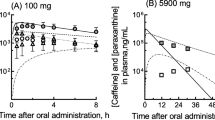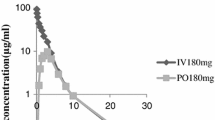Abstract
Previous studies have shown that caffeine can affect drug kinetics by altering drug binding to plasma protein, drug absorption, or drug distribution. In this study, the effect of caffeine on the in vivoprotein binding and the disposition of ceftriaxone (a highly protein-bound cephalosporin) were investigated in the rat. Ceftriaxone 100mg/kg and caffeine 20mg/kg were i.v. injected via the tail vein and ceftriaxone in plasma, plasma filtrate, urine, feces, and tissues (brain, heart, kidney, liver, gut, lung, and muscle) was assayed by HPLC with UV detection. The fraction of free ceftriaxone in plasma ranged from 5.6 to 32.8% of total ceftriaxone (3–347 μg/ml) without caffeine and showed no alteration by caffeine. The total amount of ceftriaxone excreted in urine and feces was increased significantly (p<0.05)from 13.1±1.8mg (mean±SD, 54.6% of total) to 15.3 ±1.1 mg (63.8% of total) by caffeine coadministration. The terminal half-life of ceftriaxone in plasma was shortened from 59 to 47 min, and the area under the plasma drug concentration-time curve (AUC)was reduced from 612 to 516 μg hr/ml Although the peak drug concentrations and the times of peak concentration of ceftriaxone in tissues were not altered by caffeine administration, the elimination of ceftriaxone was increased, as indicated by generally shorter half-lives (decreases ranged from 17.5% in liver to 34.2% in brain) and lower AUCvalues (from 9.0% in heart to 54.5% in brain). These results suggest that caffeine does not alter the protein binding of ceftriaxone, but enhances the elimination of ceftriaxone in the rat.
Similar content being viewed by others
References
S. Cohen and G. H. Booth. Gastric acid secretion and lower-esophageal-sphincter pressure in response to coffee and caffeine.N. Engl. J. Med. 293:897–899 (1975).
S. M. Wagner, H. S. Mekhjian, J. H. Caldwell, and F. B. Thomas. Effects of caffeine and coffee on fluid transport in the small intestine.Gastroenterology 75:379–381 (1978).
P. E. Stephenson. Physiologic and psychotropic effects of caffeine on man.J. Am. Dietetic Assoc. 71:240–247 (1977).
R. T. Jung, P. S. Shetty, W. P. T. James, M. A. Barrand, and B. A. Callingham. Caffeine: Its effect on catecholamines and metabolism in lean and obese humans.Clin. Sci. 60:527–535 (1981).
R. E. Vestal, A. H. Norris, J. D. Tobin, B. H. Cohen, N. W. Shock, and R. Andres. Antipyrine metabolism in man: Influence of age, alcohol, caffeine and smoking,Clin. Pharmacol. Ther. 18:425–432 (1975).
C. Mitoma, L. Lombrozo, S. E. LeValley, and F. Dehn. Nature of the effect of caffeine on the drug metabolizing enzymes.Arch. Biochem. Biophys. 134:434–441 (1969).
W. C. Bowman and M. J. Rand. The urinary system: Drugs affecting renal function and the urinary tract. InTextbook of Pharmacology Blackwell, London, 1980, p. 27.
M. Cocchi, C. Siniscalchi, F. Rogato, and A. Valerini. Free fatty acid levels in habitual coffee drinkers in relation to quantities consumed, sex and age.Ann. Nutr. Metab. 27:477–480 (1983).
K. J. Acheson, B. Z. Markiewiez, K. Anantharaman, and E. Jequier. Caffeine and coffee: Their influence on metabolic rate and substrate utilization in normal weight and obese individuals.Am. J. Clin. Nutr. 33:989–997 (1980).
D. H. Pitkin, P. Actor, and J. A. Weisbach. Serum protein binding alterations of selected cephalosporin antibiotics by fatty acids and their derivatives.J. Pharm. Sci. 69:354–356 (1980).
Y. Kyo, R. Murata, N. Hikichi, and H. Niwa. Effect of caffeine on plasma concentration of drugs in rats administered orally with aspirin-phenacetin preparation.Yakuzaigaku 41:94–101 (1981).
K. I. Kwon, D. W. A. Bourne, and P. C. Ho. Effect of caffeine on the plasma protein binding and the pharmacokinetics of ceftriaxone.J. Pharm. Pharmacol. 37:836–839 (1985).
A. M. Brisson and J. B. Fourtillan. Determination of cephalosporins in biological material by reversed-phase liquid column chromatography.J. Chromatogr. 223:393–399 (1981).
C. M. Metzler, G. L. Elfring, and A. J. McEwen. A package of computer programs for pharmacokinetic modeling.Biometrics 30:562–563 (1974).
D. W. A. Bourne and A. W. Wright. Modification of the digital computer program NONLIN which allows it to run on the PDP-11 minicomputer.Aust. J. Pharm. Sci. 10:23–24 (1981).
R. F. Bevill, G. D. Koritz, G. Rudawsky, L. W. Dittert, C. H. Huang, M. Hayashi, and D. W. A. Bourne. Disposition of sulfadimethoxine in swine: Inclusion of protein binding factors in a pharmacokinetic model.J. Pharmacokin. Biopharm. 10:540–550 (1982).
R. V. Patwardham, P. V. Desmond, R. F. Johnson, G. D. Dunn, D. H. Robertson, A. M. Hoyumpa, and S. Schenker. Effect of caffeine on plasma free fatty acids, urinary catecholamines and drug binding.Clin. Pharmacol. Ther. 28:398–403 (1980).
M. J. Ridd, K. F. Brown, R. G. Moore, W. G. McBride, and R. L. Nation. Diazepam plasma binding in the perinatal period: Influence of nonesterified acids.Eur. J. Clin. Pharmacol. 22:153–160 (1982).
G. Czok,. Stoffwechselbeeinflussung durch Kaffee und Coffein.Z. Ernahrungswiss. 15:109–121 (1976).
E. B. Truitt, Jr. The xanthines. In J. R. Dipalma (ed.),Drill's Pharmacology in Medicine, McGraw-Hill, New York, 1971, p. 394.
Author information
Authors and Affiliations
Additional information
This study was supported in part by a grant from Chong Kun Dang Co., Korea.
An erratum to this article is available at http://dx.doi.org/10.1007/BF01066327.
Rights and permissions
About this article
Cite this article
Kwon, K.I., Bourne, D.W.A. Effect of caffeine on ceftriaxone disposition and plasma protein binding in the rat. Journal of Pharmacokinetics and Biopharmaceutics 14, 397–408 (1986). https://doi.org/10.1007/BF01059199
Received:
Revised:
Published:
Issue Date:
DOI: https://doi.org/10.1007/BF01059199




